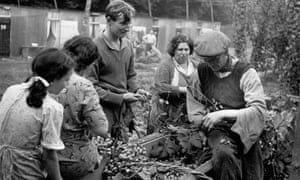KENT: One of the odder contributions to the vernacular architecture of rural Kent is to be found in spartan huts of brick and corrugated iron tucked away in solemn rows behind hedgerows. They have a military look. Most of them are empty but some still sport a washing line, a pram, and other signs of the nomadic life. But the annual confrontation of two cultures, the London East-ender and the Kentish farmer, has diminished into a very pale echo of the traditional hop-picking. One farm alone, of over 1,000 acres of hops, reckoned to face an invasion of more than 40,000 people, seeking their annual quota of fresh air, for many their only holiday and for all the method of gaining the money to buy winter clothes for the family.

Where the gardens bubbled with the cheer of large family groups, now the tractors trail the long bines up to two miles along the country lanes to the big central picking plants. The green bines with their yellowing cones are hung up on moving racks and drawn into the great machine which churns and plucks and separates the wanted fruit from the greenery. The few hands doing the last sorting process on the final belt are the only remnants of that great parade of hand labour that once signified the end of summer. So the “hills,” as the ropes sections are called, are stripped and stand bare, 1,200 to the acre, while the oasts hum with heat and a final garland celebrates the victory of the country cricket team. It is still a festival but not what it was. Now the golden apples stand ready in their turn, a bumper crop that will fall unwanted, for the market price will not pay the cost of picking. Apples haven’t been mechanised yet.